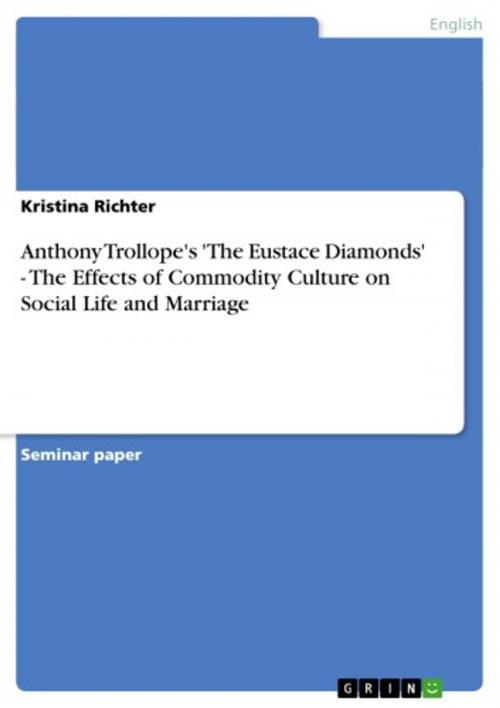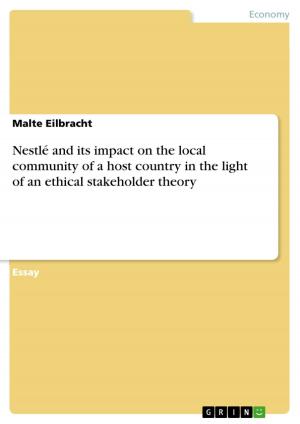Anthony Trollope's 'The Eustace Diamonds' - The Effects of Commodity Culture on Social Life and Marriage
Fiction & Literature, Literary Theory & Criticism, British| Author: | Kristina Richter | ISBN: | 9783640818068 |
| Publisher: | GRIN Publishing | Publication: | February 4, 2011 |
| Imprint: | GRIN Publishing | Language: | English |
| Author: | Kristina Richter |
| ISBN: | 9783640818068 |
| Publisher: | GRIN Publishing |
| Publication: | February 4, 2011 |
| Imprint: | GRIN Publishing |
| Language: | English |
Seminar paper from the year 2005 in the subject English Language and Literature Studies - Literature, grade: 1,3, Free University of Berlin (Institut für Englische Philologie), course: Hauptseminar, language: English, abstract: 1.Introduction Anthony Trollope, together with his works, gives us a typical example of Victorian commodity culture which he himself recognised by comparing himself with shoemakers, carpenters and other production workers. He saw writing novels as satisfying the demands of the consumers (the readers of his novels) and generation of products (his books) for the market. After his death, Trollope's autobiography was published, after which his reputation suffered a lot because people found out that he worked after a strict production schedule and, furthermore, he admitted that he wrote for money. He also called the dislike of money false and misplaced. Other writers criticised his point of view because they claimed that a true writer should not be concerned with money. Trollope, however, maintained accounting books in which he noted the number of pages he wrote, how many pages he wrote per hour etc. He saw himself as a producer of 'marketable commodities' and a typical example of this is his novel The Eustace Diamonds, which is itself a satirical representation of the circulation of commodities. In the novel, the character of Lizzie Eustace, a young widow, refuses to return a precious diamond necklace given to her by her late husband to his family, who claims it is a family heirloom and, therefore, part of their property. She tries everything she can to keep the diamonds, from faking a theft of the diamonds to trying to persuade and even blackmail several men into marrying her and, thus, protecting her from the law. She even commits perjury after the real theft of the diamonds. What follows is an account of the legal debate about whether the necklace is an heirloom or paraphernalia and the social activity connected to the debate, which is stimulated by desires, intrigues and social exchange. And it is not only the necklace that is considered as part of the circulation of commodities in the novel, but the women who are eligible for marriage are also treated in the same way. Those are Lizzie, Lucy and Lucinda - their similar names already suggest that they represent three aspects of the same topic, which is the commodification of women in the marriage market.
Seminar paper from the year 2005 in the subject English Language and Literature Studies - Literature, grade: 1,3, Free University of Berlin (Institut für Englische Philologie), course: Hauptseminar, language: English, abstract: 1.Introduction Anthony Trollope, together with his works, gives us a typical example of Victorian commodity culture which he himself recognised by comparing himself with shoemakers, carpenters and other production workers. He saw writing novels as satisfying the demands of the consumers (the readers of his novels) and generation of products (his books) for the market. After his death, Trollope's autobiography was published, after which his reputation suffered a lot because people found out that he worked after a strict production schedule and, furthermore, he admitted that he wrote for money. He also called the dislike of money false and misplaced. Other writers criticised his point of view because they claimed that a true writer should not be concerned with money. Trollope, however, maintained accounting books in which he noted the number of pages he wrote, how many pages he wrote per hour etc. He saw himself as a producer of 'marketable commodities' and a typical example of this is his novel The Eustace Diamonds, which is itself a satirical representation of the circulation of commodities. In the novel, the character of Lizzie Eustace, a young widow, refuses to return a precious diamond necklace given to her by her late husband to his family, who claims it is a family heirloom and, therefore, part of their property. She tries everything she can to keep the diamonds, from faking a theft of the diamonds to trying to persuade and even blackmail several men into marrying her and, thus, protecting her from the law. She even commits perjury after the real theft of the diamonds. What follows is an account of the legal debate about whether the necklace is an heirloom or paraphernalia and the social activity connected to the debate, which is stimulated by desires, intrigues and social exchange. And it is not only the necklace that is considered as part of the circulation of commodities in the novel, but the women who are eligible for marriage are also treated in the same way. Those are Lizzie, Lucy and Lucinda - their similar names already suggest that they represent three aspects of the same topic, which is the commodification of women in the marriage market.















